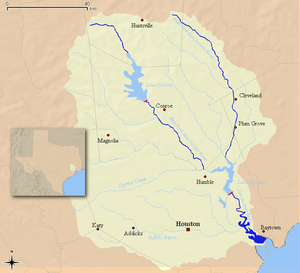Akokisa facts for kids
The Akokisa were an Native American tribe who lived in what is now Texas. They made their homes around Galveston Bay and along the lower parts of the Trinity and San Jacinto rivers. This area is mostly where Greater Houston is today. The Akokisa are thought to be a group of the Atakapa Indians, who lived close by in Lake Charles, Louisiana.
Contents
History of the Akokisa People
One of the first times Europeans wrote about the Akokisa was in 1528. A Spanish explorer named Álvar Núñez Cabeza de Vaca mentioned them, calling them the "Han." Later, in 1719, a French officer named Simars de Bellisle was held captive by the Akokisa until 1721. His stories about this time give us some information about their way of life.
In 1805, a person named John Sibley reported that the Akokisa had once lived near Matagorda Bay. This was on the west side of the Texan Colorado River a long time ago.
Around the 1750s, the Akokisa people lived in five different village groups. Some Akokisa went to the San Ildefonso Mission between 1748 and 1749. However, they left by 1755. That mission was later closed. A new mission, Nuestra Señora de la Luz, was built in 1756-57 on the Trinity River. This mission was meant to serve both the Akokisa and Bidais tribes.
By 1805, the Akokisa had fewer people and lived in only two villages. One village was near the coast, between the Sabine and Neches Rivers. The other was on the west side of the Colorado River. It is believed that the Akokisa people joined other tribes after the Texas Revolution in 1835-36.
What Does "Akokisa" Mean?
The meaning of the name Akokisa is not fully known. However, a scholar named John R. Swanton thought it might come from the Atakapa word icāk, which means "person." The Akokisa tribe was also known by several other names. These included Accockesaws, Accokesaus, Aco-ke-sas, Arkokisa, Horcoquisa, Ocosaus, Orcoquisa(s), and Orcoquisacs.
Akokisa Culture and Daily Life
The Akokisa people lived in settled villages. They built their homes to stay cool in the warm climate. Their houses were shaped like beehives and had roofs made of thatched grass or palmetto leaves. Inside, a fire pit was in the middle of the floor, with a hole in the ceiling for smoke to escape.
During the summer, Akokisa people often slept in a Chickee. This was a raised platform with a thatched roof but open sides. Their beds were made of straw and covered with animal skins.
For traveling on water and fishing, the Akokisa made dugout canoes. They carved these boats from large cypress logs.
Both Akokisa men and women liked to decorate their bodies and faces. They did this with tattoos.
The Akokisa were hunter-gatherers. This means they hunted animals and gathered plants for food. Their diet included deer, fish, oysters, and bison. They also ate a plant called cotton rakes.
A special drink called Black drink was used in some ceremonies. It was believed to help with purification.
The Akokisa were also reported to grow "superfine" maize (corn). They used the roots, or tubers, of the greenbrier vine to make meal for baking and cooking. In warm seasons, they ate bird eggs, fish, shellfish, and parts of the American lotus plant. When it was cold, they moved further inland to hunt. They hunted deer, bear, and bison. They used horses to help them hunt bison. Tanned deer hides and bear fat were important goods they traded with others.
The Akokisa Language
Quick facts for kids Akokisa |
|
|---|---|
| Region | Texas |
| Extinct | 19th century |
| Language family |
unclassified
|
| Linguist List | 096 |
| aqp-ako | |
| qm5-ako | |
The Akokisa language is now extinct, meaning no one speaks it anymore. We don't know much about it.
Some people, like Swanton, thought the Akokisa language was related to the Atakapa language. This idea came from a list of 45 words collected by Captain Jean Béranger in 1721 near Galveston. However, it's not certain if this list truly represents the Akokisa language. Béranger didn't clearly say which tribe the words belonged to.
John Sibley also reported that the Akokisa had their own unique language. He said they used sign language to talk with other Native American tribes in eastern Texas. Sibley did not say their language was connected to Atakapa.
Only two Akokisa words have been found in old Spanish records. These are Yegsa, which meant "Spaniard(s)," and Quiselpoo, which was a woman's name.


